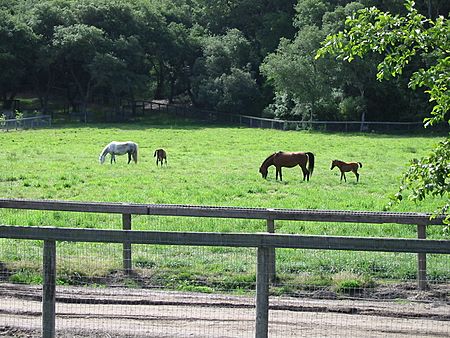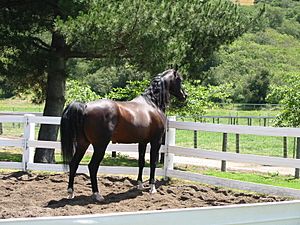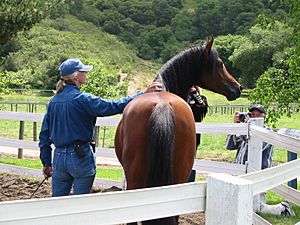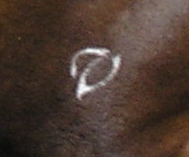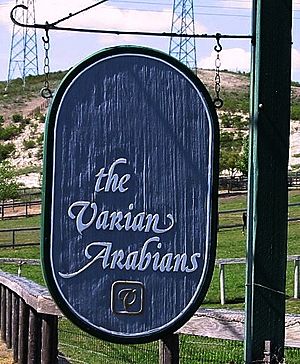Sheila Varian facts for kids
Quick facts for kids
Sheila Varian
|
|
|---|---|
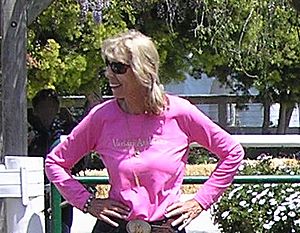
Sheila Varian in April 2010
|
|
| Born | August 8, 1937 Santa Maria, California, U.S.
|
| Died | March 6, 2016 (aged 78) |
| Alma mater | California Polytechnic State University |
| Occupation | Arabian horse breeder, trainer, owner |
| Known for |
|
| Relatives |
|
Sheila Varian (born August 8, 1937 – died March 6, 2016) was an American expert in Arabian horses. She lived and worked at her Varian Arabians Ranch in Arroyo Grande, California. Sheila loved horses from a young age. She learned about horsemanship from Mary "Sid" Spencer, a local rancher. Spencer also taught her about the vaquero (or "Californio") way of western riding.
Sheila started her own horse ranch, Varian Arabians, in 1954. Her parents helped her get started. By 1963, raising and training horses became her full-time job. She used vaquero-style training methods. However, she changed her techniques over time to suit Arabian horses. She believed these horses needed a smart but gentle approach.
Sheila Varian bred many important Arabian horses. Their family lines are found in many winning Arabian show horses in the United States. She began her breeding program with a few mares. She bred them to her national champion stallion, Bay Abi. Later, she brought three mares from Poland. This was difficult because Poland was then behind the Iron Curtain. These mares and Bay Abi became her main breeding horses. By 2016, her ranch had bred six generations of stallions from Bay Abi. Her mare lines had produced nine generations of offspring. Sheila received many awards for her work. She was inducted into the National Cowgirl Museum and Hall of Fame in 2003. This was for her work as a breeder and trainer in the vaquero style.
In 2013, Sheila was diagnosed with ovarian cancer. She wanted to protect her 230-acre ranch from being built on. In 2015, she announced a plan with the California Rangeland Trust. They would buy the development rights to the land. This would allow her ranch manager, Angela Alvarez, to continue the horse breeding program. After Alvarez, the land would go to the Trust. They would sell it, but the protection would stay with the land. The Trust would try to find a buyer who would keep the Arabian horse program going. Sheila Varian passed away on March 6, 2016, at 78 years old.
Contents
Sheila's Early Life with Horses
Sheila grew up in Halcyon, California. She loved horses and horse books. Books like those by Marguerite Henry and The Black Stallion series by Walter Farley inspired her. She said Farley's books made her interested in Arabian horses. At eight, she got her first horse, a Morgan-Percheron mix. She rode bareback until she got her first saddle at age 12.
Her parents, Eric and Wenonah Varian, did not ride horses. But they always supported Sheila's interest. They let her and her older sister ride as much as they wanted. Sheila grew to be 6 feet tall. She said she "struggled" with her height when she was young. But riding horses made her feel better: "all my troubles went away."
In 1954, Sheila and her parents started using the name "Varian Arabians." She felt her parents helped her believe in herself. They trusted her judgment with horses. They worked together to build the horse business. Her father, Eric, built fences and managed the land. Her mother, Wenonah, studied horse family trees (pedigrees). Sheila worked directly with the horses. Their ranch grew from 21 to 150 acres over time.
As a young adult, Sheila went to California Polytechnic State University. She taught high school physical education for three years. By 1963, running the Varian Arabian ranch became her full-time job. The ranch supported itself from then on. It eventually grew to 230 acres.
The Amazing Varian Horses
Sheila loved the Arabian breed. She said they have a natural interest in people. She also liked their lightness and quickness. Arabians are willing to be your partner, and they are beautiful. Sheila felt Arabian horses never let her down. She looked for horses with good temperaments and athletic ability. They also had to be attractive. She did not breed Arabians for just one type of competition. Instead, she wanted to keep improving quality. She never wanted to lose their good nature or athletic skills. Following these ideas, Sheila bred some of the most important Arabian stallions.
When she was young, Sheila wanted to find the "perfect" horse. She soon realized that breeding horses was the way to do this. Her first Arabian was a mare named Farlotta. Sheila bought her in 1952. Farlotta became a skilled spade bit horse. She won championships in both stock horse (reining) and western pleasure events.
In 1959, Sheila and her mother bought a two-year-old bay stallion named Bay-Abi. Sheila trained and showed him herself. In 1962, he was named U.S. National Champion Arabian Stallion. Later, he won U.S. National Top Ten awards in English pleasure and Western pleasure. Bay-Abi had 275 registered Arabian offspring. This included 65 champions and 24 national winners.
By 1961, Varian Arabians had a few mares. One of her first champions was Ronteza. She was the second Arabian Sheila bought. Sheila trained Ronteza herself. They won against 50 horses of all breeds. This was at the 1961 Reined Cow Horse championship in San Francisco. Sheila noticed that both Farlotta and Ronteza were from Polish stallions. She believed this mix of bloodlines made these mares so good. So, Sheila looked for Polish-bred Arabian mares to breed with her American-bred Bay-Abi. But Poland was behind the Iron Curtain, making it hard to bring horses to America.
Sheila got help from British horse breeder Patricia Lindsay. Lindsay went to Poland and bought three mares for Sheila. These mares arrived in California in December 1961. They were Bachantka, Ostroga, and Naganka. Breeding Bay-Abi with these Polish mares was very successful for Varian. By 2016, the Varian ranch had bred nine generations of horses from these foundation mares. They also had six generations of stallions from Bay Abi.
This breeding mix produced many champions. One was Bay el Bey, born in 1969. He was Bay-Abi's son and Sheila's next main stallion. Bay el Bey was U.S. Reserve National Champion stallion twice. He was also Canadian National Champion stallion in 1977. Sheila competed with her horses in English riding classes. She said Bay el Bey could have been a great reining horse. But she made him an English pleasure horse because he was so athletic.
Bay el Bey was famous for his offspring. People called him "The Kingmaker." He had 441 foals. Three of his sons were considered his best. They were Huckleberry Bey, Bey Shah, and Barbary. These three sons alone had a combined total of 650 champions.
Later generations of Varian stallions also won many awards. They produced champion show horses in many different types of riding. Huckleberry Bey was a U.S. National Reserve Champion. He then became the top sire of US National Champions for five years. In 1999, a Breyer horse model was made of him. His son, Desperado V, also became a top sire of champions. In 2004 and 2005, Desperado V was ranked the top Arabian sire. By 2009, Desperado V had produced 75 national winners.
Sheila also used horses from other bloodlines. She leased the stallion Khemosabi for his first breeding season. She also used horses from other ranches, like the Polish import Bask. In 2002, she bought Jullyen El Jamaal. He had new bloodlines not used before in the Varian program. Sheila always wanted her mares to be good riding animals. Every mare in her program was trained under saddle.
Varian-bred horses now have a registered name ending with the capital letter "V". The Varian ranch also uses the first letter of each mare's name for their foals. Varian-bred horses are also freeze branded with the Varian "V" logo.
Sheila's Training Style and Vaquero Tradition
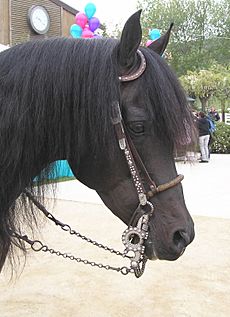
Vaqueros were the first cowboys in California. They were horsemen and cattle herders from Spanish Mexico. Sheila learned horse training methods from this tradition. When she was a teenager, Mary "Sid" Spencer taught her about horsemanship. Spencer was a Morgan horse breeder and cattle rancher. She taught Sheila how to train and ride horses. She also showed her how to work cattle in the mountains. Spencer introduced her to vaquero training methods. Sheila learned to recognize good horse conformation (how a horse is built).
After learning traditional vaquero methods, Sheila changed her training style. This happened after she met Tom Dorrance. He taught her a "soft approach" to working with horses. This influenced Sheila's training ideas. Sheila used vaquero-influenced methods. But she believed modern, well-bred horses needed a gentler way. She said, "All good horses, like smart children, need good instruction, but they don't need harsh instruction."
Sheila was one of the few experts still teaching about vaquero equipment and history. She was very interested in the history of the spade bit horse in California. The spade is a complex bit. It can only be used on a highly trained horse by a skilled rider. In the vaquero tradition, using it shows the highest trust between horse and rider. Training a spade bit horse takes five to seven years. The goal is to create a finely tuned working horse and partner. It focuses on quality, not speed. The horse's conformation is also important. A spade bit horse needs a higher neck and well-carried head.
Traditionally, the vaquero method starts a young horse with a hackamore. This is headgear with a heavy rawhide noseband, called a bosal, instead of a bit. As the horse learns, it moves to lighter bosals. Then it goes into a "two-rein" period. This uses a bridle with a "half breed" curb bit along with a light bosal. The rider uses two sets of reins. After several years, the horse moves to the spade bit.
Sheila changed this tradition a bit. She started young horses under saddle at age three. She began with a bridle and a snaffle bit. She felt this gave clearer signals to a young, sensitive horse. Then she introduced the traditional hackamore. After a few months, she taught neck reining. This allows a horse to be ridden with one hand. After a year or two, she introduced the two-rein. Once the horse understood the bit, the bosal was removed. The horse was ridden in just the curb bit. When ready for the full spade bit, the horse went back into the two-rein. She introduced horses to the spade bit at age seven or eight. This was only if they had the right build and personality. If she trained a spade bit horse for herself, she kept it for life.
Sheila thought Arabians were the most "people-oriented" horse breed. She said, "No other horse will leave his food to come and see you." She noted they are a "hot-blooded" breed. This means they are sensitive and won't tolerate rough handling. She disagreed with those who thought Arabians were too spirited for trail riding. She taught her horses good manners. She even roped from her horses and took them into the mountains.
She believed Arabians needed a smart and gentle approach. She supported trainers who used methods like those of Ray Hunt and Tom Dorrance. Dorrance's ideas were especially good for Arabians. She felt the breed was naturally gentle. She pointed out that any horse can become "hot" if kept in a stall all day. Sheila compared Arabians to smart children. They show their ability with joy, but you cannot bully them.
Sheila's Legacy and Awards
The Varian Arabian Ranch has been ranked many times. It is one of the top Arabian breeders of winning horses. This is according to the United States Equestrian Federation (USEF). The ranch was first in 2008. It was in the top ten from 2006 to 2010. In 2013, Arabian Horse World magazine ranked the Varian breeding program as the number one breeder of both English-type and Western-type Arabian horses.
Sheila Varian herself received the 2001 Ellen Scripps Davis Memorial Breeders' Cup from the USEF. This award goes to someone who consistently breeds outstanding show horses. In the Arabian horse world, Sheila received a lifetime achievement award in 2005. She was also the Arabian Professional & Amateur Horseman's Association's 2009 Breeder of the Year.
Sheila Varian was inducted into the Cowgirl Hall of Fame in 2003. She was honored for her work as a horse breeder and trainer. This award recognized her deep connection to the vaquero tradition.
| USEF rankings | Placing |
|---|---|
| Leading Arabian breeder 2004 | 19th |
| Leading Arabian breeder 2005 | 18th* |
| Leading Arabian breeder 2006 | 6th |
| Leading Arabian breeder 2007 | 7th |
| Leading Arabian breeder 2008 | 1st |
| Leading Arabian breeder 2009 | 4th |
| Leading Arabian breeder 2010 | 3rd |
| Leading Arabian breeder 2011 | 11th |
| Leading Arabian breeder 2012 | 11th |
| Leading Arabian breeder 2013 | 17th |
| Leading Arabian breeder 2014 | 7th |
| Leading Arabian breeder 2015 | 77th |
In November 2015, Sheila announced a plan with the California Rangeland Trust. She wanted to protect her ranch from being developed. She started this project so her ranch manager, Angela Alvarez, could continue the horse breeding program. After Alvarez, the property would be given to the Trust. It would be sold, but the land protection would stay. The Trust would try to find a buyer who would also want to keep the Arabian horse breeding program going.
Sheila Varian was diagnosed with ovarian cancer in 2013. She passed away on March 6, 2016, at 78 years old. When news of her death spread, the California Rangeland Trust website crashed. This was because so many people visited it. Supporters then set up a backup site for donations to help with the conservation effort.
See also
- Russell and Sigurd Varian, uncles of Sheila Varian
- John Osborne Varian, grandfather of Sheila Varian


